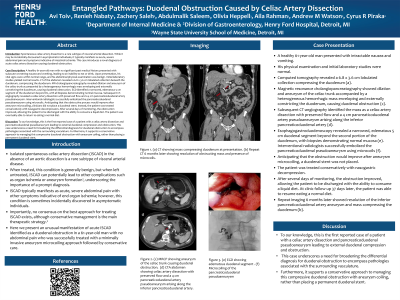Monday Poster Session
Category: Small Intestine
P3256 - Entangled Pathways: Duodenal Obstruction Caused by Celiac Artery Dissection
Monday, October 28, 2024
10:30 AM - 4:00 PM ET
Location: Exhibit Hall E

Has Audio

Avi Toiv, MD
Henry Ford Hospital
Detroit, MI
Presenting Author(s)
Avi Toiv, MD1, Renieh Nabaty, MD1, Zachary Saleh, MD1, Abdulmalik Saleem, MD2, Olivia Heppell, BS3, Aila Rahman, BS3, Andrew Watson, MD2, Cyrus Piraka, MD2
1Henry Ford Hospital, Detroit, MI; 2Henry Ford Health, Detroit, MI; 3Wayne State School of Medicine, Detroit, MI
Introduction: Spontaneous celiac artery dissection is a rare subtype of visceral arterial dissection. While it may be incidentally discovered in asymptomatic individuals, it typically manifests as acute, severe abdominal pain and symptoms indicative of intestinal ischemia. This case introduces a novel diagnosis of acute celiac artery dissection causing duodenal obstruction.
Case Description/Methods: A healthy 61-year-old man with no significant past medical history presented with subacute worsening nausea and vomiting, leading to an inability to eat or drink. Upon presentation, his vital signs were within normal range, and his abdominal physical examination was benign. Initial laboratory studies yielded normal results. CT of the abdomen revealed a 6.8 x 3.6 cm lobulated collection beneath the duodenum, compressing the duodenum. MR-cholangiopancreatography revealed dilation and aneurysm of the celiac trunk accompanied by a heterogeneous hemorrhagic mass enveloping and externally constricting the duodenum, causing duodenal obstruction. EGD identified a narrowed, edematous 5 cm segment of the duodenum beyond D2, with all biopsies demonstrating normal mucosa. Subsequent CT-angiography revealed a celiac artery dissection with preserved flow and a 4 cm pancreaticoduodenal artery pseudoaneurysm. Interventional radiologists successfully embolized the pancreaticoduodenal pseudoaneurysm using microcoils. Anticipating that the obstructive process would improve after aneurysm microcoiling, clinicians did not place a duodenal stent. Instead, the patient was treated conservatively with nasogastric decompression. After several days of monitoring, the obstruction improved, allowing the patient to be discharged with the ability to consume a liquid diet. The patient was eventually able to return to eating a normal diet.
Discussion: To our knowledge, this is the first reported case of a patient with a celiac artery dissection and pancreaticoduodenal pseudoaneurysm leading to external duodenal compression and obstruction. This case underscores a need for broadening the differential diagnosis for duodenal obstruction to encompass pathologies associated with the surrounding vasculature. Furthermore, it supports a conservative approach to managing this compressive duodenal obstruction with aneurysm coiling, rather than placing a permanent duodenal stent.
Disclosures:
Avi Toiv, MD1, Renieh Nabaty, MD1, Zachary Saleh, MD1, Abdulmalik Saleem, MD2, Olivia Heppell, BS3, Aila Rahman, BS3, Andrew Watson, MD2, Cyrus Piraka, MD2. P3256 - Entangled Pathways: Duodenal Obstruction Caused by Celiac Artery Dissection, ACG 2024 Annual Scientific Meeting Abstracts. Philadelphia, PA: American College of Gastroenterology.
1Henry Ford Hospital, Detroit, MI; 2Henry Ford Health, Detroit, MI; 3Wayne State School of Medicine, Detroit, MI
Introduction: Spontaneous celiac artery dissection is a rare subtype of visceral arterial dissection. While it may be incidentally discovered in asymptomatic individuals, it typically manifests as acute, severe abdominal pain and symptoms indicative of intestinal ischemia. This case introduces a novel diagnosis of acute celiac artery dissection causing duodenal obstruction.
Case Description/Methods: A healthy 61-year-old man with no significant past medical history presented with subacute worsening nausea and vomiting, leading to an inability to eat or drink. Upon presentation, his vital signs were within normal range, and his abdominal physical examination was benign. Initial laboratory studies yielded normal results. CT of the abdomen revealed a 6.8 x 3.6 cm lobulated collection beneath the duodenum, compressing the duodenum. MR-cholangiopancreatography revealed dilation and aneurysm of the celiac trunk accompanied by a heterogeneous hemorrhagic mass enveloping and externally constricting the duodenum, causing duodenal obstruction. EGD identified a narrowed, edematous 5 cm segment of the duodenum beyond D2, with all biopsies demonstrating normal mucosa. Subsequent CT-angiography revealed a celiac artery dissection with preserved flow and a 4 cm pancreaticoduodenal artery pseudoaneurysm. Interventional radiologists successfully embolized the pancreaticoduodenal pseudoaneurysm using microcoils. Anticipating that the obstructive process would improve after aneurysm microcoiling, clinicians did not place a duodenal stent. Instead, the patient was treated conservatively with nasogastric decompression. After several days of monitoring, the obstruction improved, allowing the patient to be discharged with the ability to consume a liquid diet. The patient was eventually able to return to eating a normal diet.
Discussion: To our knowledge, this is the first reported case of a patient with a celiac artery dissection and pancreaticoduodenal pseudoaneurysm leading to external duodenal compression and obstruction. This case underscores a need for broadening the differential diagnosis for duodenal obstruction to encompass pathologies associated with the surrounding vasculature. Furthermore, it supports a conservative approach to managing this compressive duodenal obstruction with aneurysm coiling, rather than placing a permanent duodenal stent.
Disclosures:
Avi Toiv indicated no relevant financial relationships.
Renieh Nabaty indicated no relevant financial relationships.
Zachary Saleh indicated no relevant financial relationships.
Abdulmalik Saleem indicated no relevant financial relationships.
Olivia Heppell indicated no relevant financial relationships.
Aila Rahman indicated no relevant financial relationships.
Andrew Watson: Cook Medical – Consultant.
Cyrus Piraka: Aries and US Endoscopy – Grant/Research Support. NIH – Grant/Research Support.
Avi Toiv, MD1, Renieh Nabaty, MD1, Zachary Saleh, MD1, Abdulmalik Saleem, MD2, Olivia Heppell, BS3, Aila Rahman, BS3, Andrew Watson, MD2, Cyrus Piraka, MD2. P3256 - Entangled Pathways: Duodenal Obstruction Caused by Celiac Artery Dissection, ACG 2024 Annual Scientific Meeting Abstracts. Philadelphia, PA: American College of Gastroenterology.

